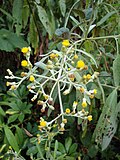Note: This is a project under development. The articles on this wiki are just being initiated and broadly incomplete. You can Help creating new pages.
Blumea balsamifera - Kukundara
Kukundara is a flowering plant belonging to the Blumea genus, Asteraceae family. Kukundara is also known as Blumea balsamifera, sambong, kakoranda, bhamaruda, etc.
Contents
- 1 Uses
- 2 Parts Used
- 3 Chemical Composition
- 4 Common names
- 5 Properties
- 6 Habit
- 7 Identification
- 8 List of Ayurvedic medicine in which the herb is used
- 9 Where to get the saplings
- 10 Mode of Propagation
- 11 How to plant/cultivate
- 12 Season to grow
- 13 Required Ecosystem/Climate
- 14 Kind of soil needed
- 15 Commonly seen growing in areas
- 16 Photo Gallery
- 17 References
- 18 External Links
Uses
Wounds, Fever, Rheumatism, Headache, Cold, Blotches, Cough, Diarrhea, Stomach spasms
Parts Used
Chemical Composition
Ngai Camphor oil consists almost entirely of l-borneol. It is redistilled to obtain the refined camphor for use in medicine. The dried leaves contain sesquiterpene lactones. [1]
Common names
| Language | Common name |
|---|---|
| Kannada | Kukuraadra |
| Hindi | Kakoranda, Kukronda |
| Malayalam | Bangachappa, Sombong |
| Tamil | Cuvarru mullanki, Kattu mullani |
| Telugu | |
| Marathi | NA |
| Gujarathi | NA |
| Punjabi | NA |
| Kashmiri | NA |
| Sanskrit | Kukkuradru, Kukundara, Tamracuda |
| English | Ngai camphor |
Properties
Reference: Dravya - Substance, Rasa - Taste, Guna - Qualities, Veerya - Potency, Vipaka - Post-digesion effect, Karma - Pharmacological activity, Prabhava - Therepeutics.
Dravya
Rasa
Tikta (Bitter), Katu (Pungent)
Guna
Laghu (Light), Ruksha (Dry)
Veerya
Ushna (Hot)
Vipaka
Katu (Pungent)
Karma
Kapha, Vata
Prabhava
Habit
Identification
Leaf
| Kind | Shape | Feature |
|---|---|---|
| Simple | Oblong | 15-18 × 3.5-5 cm, abaxially densely silky-lanate, adaxially rugose and pilose with blunt multicellular hairs |
Flower
| Type | Size | Color and composition | Stamen | More information |
|---|---|---|---|---|
| Unisexual | 2-4cm long | Yellow | 5 | Veins 10-12 pairs. Capitula 6-7 mm, in spreading pyramidal panicles, pedunculate |
Fruit
| Type | Size | Mass | Appearance | Seeds | More information |
|---|---|---|---|---|---|
| Oblong | 4-6 mm | Clearly grooved lengthwise, Lowest hooked hairs aligned towards crown | Central florets yellow | Many | {{{6}}} |
Other features
List of Ayurvedic medicine in which the herb is used
- Vishatinduka Taila as root juice extract
Where to get the saplings
Mode of Propagation
How to plant/cultivate
A plant of the tropics and subtropics, it can be found at elevations from sea level to 2,200 metres[3]
Season to grow
Required Ecosystem/Climate
Kind of soil needed
Commonly seen growing in areas
Dry fields, Grasslands, Mountain slopes, Thickets, Roadsides.
Photo Gallery
- Ao men zhi wu zhi (2006.12) (19561235570).jpg
Whole herb
References
- ↑ Chemical Constituents
- ↑ Plant description
- ↑ Cultivation Details
- ↑ Cite error: Invalid
<ref>tag; no text was provided for refs namedSeason to grow - ↑ Cite error: Invalid
<ref>tag; no text was provided for refs namedRequired Ecosystem/Climate
External Links
- Pages with broken file links
- Pages with reference errors
- Ayurvedic Herbs known to be helpful to treat Wounds
- Ayurvedic Herbs known to be helpful to treat Fever
- Ayurvedic Herbs known to be helpful to treat Rheumatism
- Ayurvedic Herbs known to be helpful to treat Headache
- Ayurvedic Herbs known to be helpful to treat Cold
- Ayurvedic Herbs known to be helpful to treat Blotches
- Ayurvedic Herbs known to be helpful to treat Cough
- Ayurvedic Herbs known to be helpful to treat Diarrhea
- Ayurvedic Herbs known to be helpful to treat Stomach spasms
- Herbs with Leaves used in medicine
- Herbs with Flowers used in medicine
- Herbs with common name in Kannada
- Herbs with common name in Hindi
- Herbs with common name in Malayalam
- Herbs with common name in Tamil
- Herbs with common name in Sanskrit
- Herbs with common name in English
- Habit - Evergreen shrub
- Index of Plants which can be propagated by Seeds
- Herbs that are commonly seen in the region of Dry fields
- Herbs that are commonly seen in the region of Grasslands
- Herbs that are commonly seen in the region of Mountain slopes
- Herbs that are commonly seen in the region of Thickets
- Herbs that are commonly seen in the region of Roadsides
- Herbs
- Ayurvedic herbs that don't have seed photos
- Asteraceae




